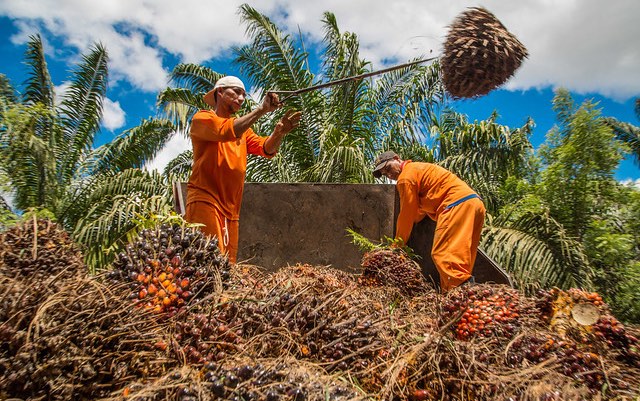Over the past two decades, global palm oil production has increased rapidly to meet rising demand from the food, energy, and industrial sectors. Palm oil is a common ingredient in many food products including bread, cereal, peanut butter, chocolate, and margarine; in personal products such as shampoo, cosmetics, and cleaning products; and a source of biodiesel fuel. Unfortunately, the global palm oil expansion has also exacted a high price on the environment: In some areas, oil palm plantations have displaced forests and peatlands, resulting in biodiversity losses and increased greenhouse gas emissions. Finding a solution may be a challenge, but not impossible.
Global demand and the production of palm oil is projected to continue rising in the coming decades. Absent changes in policy or technology, this means the environmental repercussions will only intensify. In a new policy brief, we examine this dilemma and suggest ways to mitigate the trade-offs between rising demand and environmental costs.
Innovations such as improved seeds and better management practices could boost yields and play a key role in reducing the environmental impacts of palm oil production. But opinions differ on whether higher yields would increase or decrease pressure to clear more land. The answer depends on whether higher yields will mean higher returns for producers, or whether increased production will reduce prices and thus incentives for increased production. This is a critical policy issue for producer countries and the global community.
Using IFPRI’s International Model for Policy Analysis of Agricultural Commodities and Trade (IMPACT), researchers from IFPRI, the Center for International Forestry Research (CIFOR), the Commonwealth Scientific and Industrial Research Organisation (CSIRO), and the World Wildlife Fund (WWF) recently analyzed the future course of palm oil demand and production from 2010 to 2050 and the likely impacts of different yield scenarios. We found that boosting yields can substantially slow or even halt the global expansion of harvested areas.
We first estimated that total global oilseed demand and production will increase by about 85% between 2010 and 2050. Rising demand for both food and industrial uses (of which biofuels represent a relatively small share) will drive growth, although growth rates are expected to slow compared to rates of the recent past.
At the “business as usual” rate of expansion, harvested area for oil palm is projected to more than double by 2050, rising from 14.6 million hectares to 31.1 million hectares. We then compared this to three alternative scenarios of low, medium, and high additional yield growth These led to reductions in cultivated land of approximately 18%, 33%, and 53%, respectively, compared to the 2050 baseline. In general, higher yields lead to lower palm oil prices, reducing the incentives to expand.
These results highlight the considerable impact that yield-increasing innovations can have on protecting the environment. Reductions in oil palm harvested area (relative to baseline projections in 2050) are greatest in East Asia and the Pacific, notably Indonesia and Malaysia, where most palm oil production takes place, though other regions also see reductions.
To achieve these reductions, countries must adopt appropriate technological innovations. But that won’t be sufficient in the short term. Technology must be accompanied by policy measures that discourage oil palm expansion that relies on forest and peatland conversion, and by effective enforcement and careful monitoring to prevent environmental damage.
There is no one-size-fits-all policy solution. Forest clearing for oil palm area expansion—the cause of the biggest environmental impacts—varies greatly by region. In Southeast Asia, forest clearing has accounted for about 45% of oil palm expansion since 1989. In Mexico and Central America, by contrast, it has accounted for as little as 2%. Appropriate policy responses, then, will depend not only on available technologies or the changing dynamics of global markets, but on the differing historical and environmental contexts of individual palm oil-producing countries.
It is also important to distinguish between smallholders and larger-scale producers of palm oil when addressing such challenges, since the two groups face different constraints and opportunities in terms of both adopting yield-enhancing technologies and expanding the area for oil palm cultivation. Large producers typically have more secure land tenure and better access to inputs and finance, as well as to processing facilities and markets. Service delivery to smallholders tends to be costlier.
To overcome these disparities, policies are needed that clarify land rights and improve smallholders’ access to resources, technologies, and markets to help them innovate more quickly. This could include the organization of smallholders into cooperatives to improve their market access, targeted technology transfer programs, improved access to finance for adopting higher-productivity seed varieties, and improved access to fertilizers and other productive resources.
For countries in Southeast Asia and South America, where oil palm expansion in recent decades has relied significantly on clearing of forests and peatlands, measures such as sustainability criteria, certification, land regulation, and protection of natural areas will be most relevant. Changes in palm oil demand and production and how they will affect livelihoods, food security, and the environment deserve careful consideration through further research and development of appropriate policy frameworks.
Keith Wiebe is an IFPRI Senior Research Fellow and the leader of the CGIAR Global Futures and Strategic Foresight initiative (GFSF). Maria Garcia is a former IFPRI Communications Intern.
This work was funded by the CGIAR Research Program on Policies, Institutions, and Markets (PIM) led by IFPRI, the CGIAR Research Program on Climate Change, Agriculture and Food Security (CCAFS), and the CGIAR Research Program on Forests, Trees and Agroforestry (FTA).







